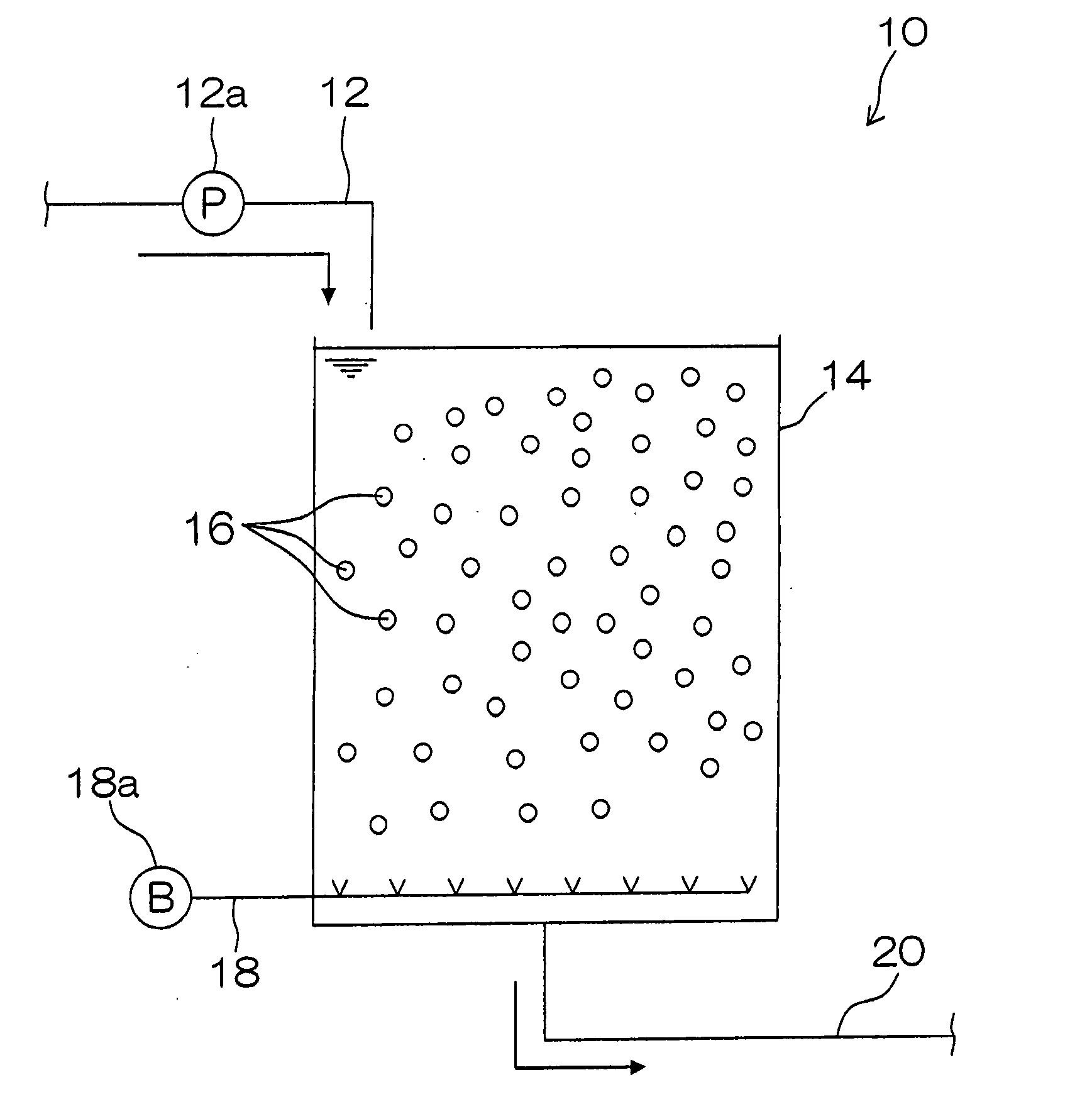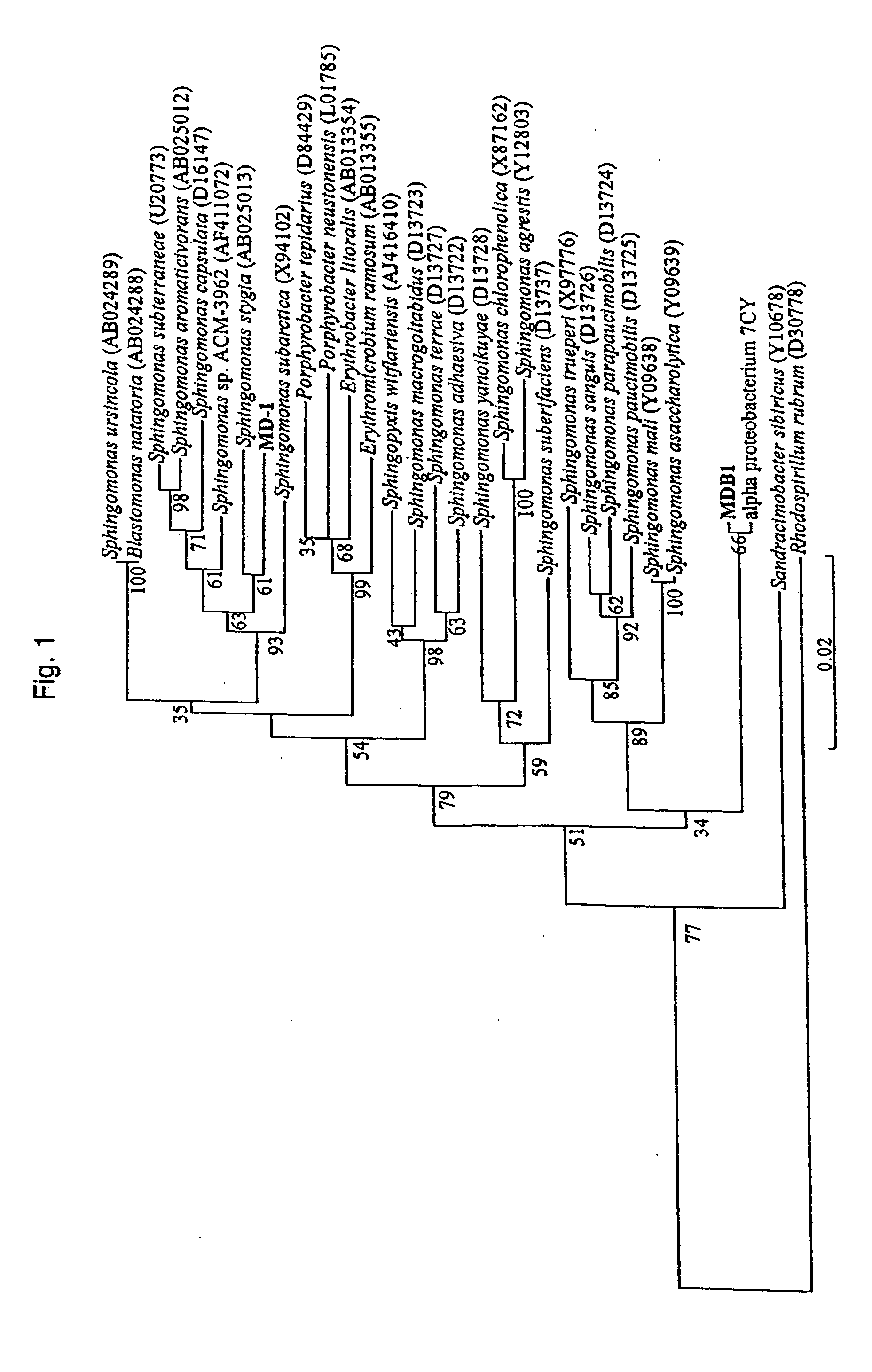Method and equipment for treating microcystin-containing water
a technology of microcystin and equipment, which is applied in the direction of sustainable biological treatment, biological water/sewage treatment, chemistry apparatus and processes, etc. it can solve the problems of increasing the pollution of closed water areas, no method for treating poisoning, and large amount of microcystin released by crushed cyanobacteria, so as to reduce the energy required and reduce the effect of treatment efficiency and preventing the production of by-products
- Summary
- Abstract
- Description
- Claims
- Application Information
AI Technical Summary
Benefits of technology
Problems solved by technology
Method used
Image
Examples
example 1
Treatment by Spraying Strain MDB1
[0057] In an Example 1, the above-described strain MDB1 is cultured in the nutrient broth medium of 2 liter at 30° C. for one week, and a culture solution obtained by culturing the strain MDB1 is centrifuged so as to separate an exclusively bacterial suspension from the medium components. Then, the separated bacterial suspension is adjusted so as to be a cell concentration of 108 cells / m2, and is sprayed over 4 m2-wide water surface of an experimental aquarium which is packed with 4 m3 of water having a microcystin concentration of 20 μg / L, so as to carry out an experiment. According to the Example 1, as time passed since the start of the experiment, the microcystin concentration in the microcystin-containing water is reduced. After two weeks, the water can be treated so that a microcystin concentration is equal to or more than 1 μg / L which is defined as a standard by WHO.
[0058] As a modification of the Example 1, the above-described bacterial susp...
example 2
Treatment Using Entrapping Immobilization Method of Strain MDB1
[0060] In an Example 2, in order to carry out a following experiment, a closed-water area polluted with microcystin is treated using a microcystin-containing water treatment equipment 10 according to a first embodiment of the present invention shown in FIG. 5.
[0061] As shown in FIG. 5, in the treatment equipment 10, microcystin-containing water is pumped up from a closed-water area by an introduction pump 12a which is attached to an introduction tube 12 as an introduction section, and the water is supplied to a reaction vessel 14 through the introduction tube 12. A large number of pellets 16 are formed by entrapping and immobilizing the strain MDB1, and are incorporated in the reaction vessel 14 as a treatment section. A diffuser tube 18 as a diffusing device is disposed on the bottom of the reaction vessel 14 so as to diffuse air by driving a blower 18a attached to the diffuser tube 18. Therefore, while the air is sup...
example 3
Treatment Using Attachment Immobilization Method of Strain MDB1
[0064] In an Example 3, in order to carry out a following experiment, an agricultural pool 100 as a closed-water area containing microcystin is treated using a microcystin-containing water treatment equipment 30 according to a second embodiment of the present invention as shown in FIG. 6.
[0065] In the treatment equipment 30, a culture tank 32 is disposed as a culture section and a supply section on one shore of the agricultural pool 100, which cultures the strain MDB1 in the nutrient broth medium stored in the culture tank 32. The cultured bacterial suspension of the strain MDB1 is supplied via a supply tube 36 to a treatment section 38 which is placed in the agricultural pool 100, by driving a supply pump 34 attached to the supply tube 36. The treatment section 38 is provided so that a plurality of net rings 40 are linked and fixed to a linking member 42, and a plurality of floating members 44 are floated on the water...
PUM
| Property | Measurement | Unit |
|---|---|---|
| pH | aaaaa | aaaaa |
| pH | aaaaa | aaaaa |
| temperature | aaaaa | aaaaa |
Abstract
Description
Claims
Application Information
 Login to View More
Login to View More - R&D
- Intellectual Property
- Life Sciences
- Materials
- Tech Scout
- Unparalleled Data Quality
- Higher Quality Content
- 60% Fewer Hallucinations
Browse by: Latest US Patents, China's latest patents, Technical Efficacy Thesaurus, Application Domain, Technology Topic, Popular Technical Reports.
© 2025 PatSnap. All rights reserved.Legal|Privacy policy|Modern Slavery Act Transparency Statement|Sitemap|About US| Contact US: help@patsnap.com



